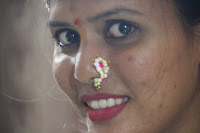The sugar bead jewelry made by Kavita Dhuri Kadu
Sankrant 2016 came fast. It was the first festival after my marriage in Dec 2015. My family brought me gifts of a black saree for Sankrant and the sugar bead jewelry as is the tradition in most communities in Maharashtra. This is not a Koli tradition but we accepted it in our family as my SIL Mangala Vahini wanted to do it for me as is her Maratha family's tradition. It was done for my Nephew and his wife Dipti too. Haldi kunku is traditionally for women but we included the men too. The sugar bead jewelry for both me and Dipti was made by our dear friend Kavita Dhuri Kadu.
The tradition of a black saree is practiced in Maharashtra as on the day of Sankrant the sun starts its movement to the Northern hemisphere and marks the end of Winter solstice. It is the coldest day of winter. It is believed that wearing black on the Sankrant ensures that the rest of the year is a bright one while it keeps the body warm.
I had ordered this Bengali kantha work saree from 'Suryabartta' owned by
Sayantani's Mother but I was unable to wear it on the day as I had left it in Dad's place and funnily brought just the blouse to my sasural. So my bro Vijay had to rush to Dadar market to get another black saree for me which you see in the first pic.
That's Dipti my nephew's beautiful wife in all her Sankrant finery.
Dipti & Sujal
The Parsi vegetarian dinner I had cooked up for the family on that day that year.
Such a memorable day it was!



























